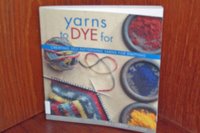We will be using procion dye with a soda ash fixer with a cold water approach. Procion is my dye of choice since it works on cottons, silks and other cellulose fibers. Since I am allergic to wool I don't do the heat approach with vinegar much. We did a order of dye from Dharma - I ordered a couple new colors for fun. I realize I could mix the various primaries to get any color...but I find it more rewarding to simply get them pre-mixed. I thought wedgewood blue and seafoam would be nice colors for summer.
I also reviewed my stash. It is extensive and discovered two things. The first - I have lots of wool which needs to be removed from the house...so I set up a Stash Party later in April for this purpose. The second - I do not have any yarn that I can knit well which will dye well. So I ordered some from KnitPicks. The yarn is 60% cotton and 40% modal. I have never heard of modal but the dictionary said it was some type of British cellulose fiber. The cotton should take the dye fine. I wonder how the modal will dye. Perhaps, the yarn will arrive in time for some testing. I am thinking of posting a question on the Dyers List to see what the collective has to say.
 Since I know little about self-patterning yarns I ordered from the LA Public Library the book Yarns to Dye For - creating self-patterning yarns for knitting by Kathleen Taylor. It arrived yesterday. I skipped the stuff which discussed dyes and how to dye since it wasn't really applicable to what we are doing and went straight for the patterns. I really have not desire to copy their patterns I just wanted to know what patterns were possible and the basics about how to derive them.
Since I know little about self-patterning yarns I ordered from the LA Public Library the book Yarns to Dye For - creating self-patterning yarns for knitting by Kathleen Taylor. It arrived yesterday. I skipped the stuff which discussed dyes and how to dye since it wasn't really applicable to what we are doing and went straight for the patterns. I really have not desire to copy their patterns I just wanted to know what patterns were possible and the basics about how to derive them.There are four different patterns; stripes, spots, zig zags and graduations of color. In the right combination you can come up with yarn that will yield that Fair Isle look without having to change yarns all the time. I'd like to try each to see how they come out.
The key to self patterning yarn is that one must come up with a forty foot skein in order to get good pattern variation and visual interest. The author has tried many lengths and this is her default length. This is a definite plus for reading the book. I would have never done a skein that long. Also, she recommends that the skein not be more than sixty rounds. So if I do my math right that is about 2400 feet or 800 yards.
It's pretty easy to get stripes. Just paint measured sections of color onto the skein. The length/width of the stripe will vary by what you are knitting. Most of the patterns in the book had 36 or 72 inches sections in one color followed by another. If the two colors did not blend well, she recommends leaving about a one half inch space between the colors to avoid blending. To get a zig zag pattern use smaller sections of color. A real precise pattern will require a yardstick as part of the process.
To get that Fair Isle knit look, dashes are handpainted onto the skein. For a spot of color 1 or 2 knitted stitches long - - make a one inch dash. For 3-5 knitted stitches of a color go for two inch dash. These spots in combination with stripes give that Fair Isle look I always see on socks.
To achieve the slow graduation of color from light to dark - be warned - - it is a messy process. To get the color of the yarn to gradually change from dark to light, you start by rolling the yarn into a loose ball. The center-pull type ball will not work. Immerse the ball into the dye bath and make sure the dye soaks all the way through. Over a period of 20-60 minutes slowly remove the yarn yard by yard and drop into a rinse bucket. [I'm not sure when we apply the soda ash on this approach...prior to balling the yarn...After the ball is made...or into the dye bath. Hopefully, the Dye Master will know the answer.] The author also suggests boosting the dark color by adding some black or other dark color near the end of the process.
I won't firm up what I will dye until the mailman comes with my yarn. I do think some multiple color dashes in a Fibonacci series would be good to try for that short row knitting. I will let all this info just slosh around in my brain for a couple of weeks. Looks to be an interesting April.
2 comments:
Short row knitting makes the math more complex, doesn't it? But, so satisfying to get it right.
This is fascinating - I only recently became aware of these self-patterning yarns (I've never done any dyeing and don't knit much) and had been wondering how it was done. Can't wait to see what you come up with!
Post a Comment